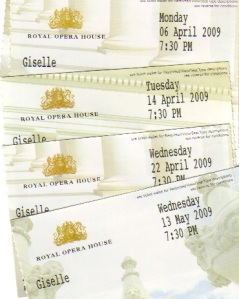
The joys of seeing different casts
The other day I got an email from a friend inviting me to see the Royal Ballet’s current production of Giselle. He had been sent a promotional offer to one of the performances and knew that I am a major ballet buff. “Interested?”, he asked. Thanks, I replied, but I am already booked for 6 other performances of this ballet so will probably give this one a miss. He was shocked: “You are going 6 times?! Wow, you must really, REALLY like this ballet!”
Certainly the fact that I do helps (believe me, I wouldn’t sit through Spartacus more than once, yawn!) but the thing that drives me back to the same production more than once is the opportunity to see different dancers and different interpretations of the same role. Great dancers bring their unique gifts to the stage and can make us feel as if we were watching any classic, no matter how overstaged, for the first time.
It is a fact that “the more [ballet] is seen, the more will be wanted” (How to Enjoy Ballet, by Clement Crisp and Mary Clarke). Once I caught the dance-watching bug I quicky realised that just one taste of each performance wasn’t going to be enough: you book months in advance and then spend weeks looking forward to something that vanishes so quickly before your eyes. Or, as New York City Ballet says (rather more eloquently) somewhere in their website:
“Ballet is as fragile and as magical as a snowflake. It exists only when dancers are dancing and no two performances are ever alike. Blink and the moment melts away. Critics and dance writers extend the window of opportunity to catch these on-stage “miracles of nature”…”
But there are more reasons why you should be spreading your bets: That one cast you picked so carefully gets changed. Some dance critic whose opinion you trust swears by that other pairing you have never seen and steers you towards a whole new world of possibilities. You hear there’s a new whizkid on the block tackling that fierce role for the first time. The solution? Downgrade your seats (we certainly wouldn’t advise breaking the bank to support your ballet habit) and upgrade the amount of bookings. And always keep an eye out for the castings lottery!








